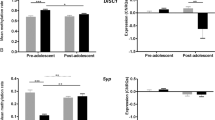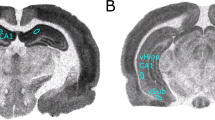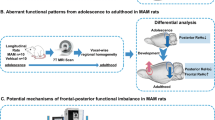Abstract
Gestational methylazoxymethanol acetate (MAM) exposure has been suggested to produce neural and behavioral abnormalities similar to those seen in schizophrenia. In order to assess MAM treatment as a model of schizophrenia, pregnant female rats were injected with MAM (22 mg/kg) on gestational day 17 and their offspring were assessed in adulthood on a series of cognitive tasks. The first experiment involved an attentional set-shifting task, a rodent analog of the Wisconsin card sort task. In experiment 2, animals were tested on the 5-choice serial reaction time task, a rodent analog of the continuous performance task. In the final experiment animals were assessed on a differential reinforcement of low rate of responding 20 s schedule of reinforcement (DRL-20), a task that is sensitive to changes in inhibitory control. In the first experiment, MAM-treated animals required a greater number of trials than controls to successfully learn an extradimensional shift on the set-shifting task, and had difficulties in learning to reverse a previously acquired discrimination. In contrast, MAM-treated animals showed little impairment on the 5-choice task, aside from a modest but consistent increase in premature responding. Finally, MAM exposed animals showed substantial impairments in DRL performance. Post-mortem analysis of brain tissue showed significant decreases in tissue weight in the hippocampus, parietal cortex, prefrontal cortex, and dorsal striatum of MAM-treated animals. These results support the notion that MAM treatment may simulate some aspects of schizophrenic cognition.
Similar content being viewed by others
Log in or create a free account to read this content
Gain free access to this article, as well as selected content from this journal and more on nature.com
or
References
Archer T, Hiltunen AJ, Jarbe TU, Kamkar MR, Luthman J, Sundstrom E et al (1988). Hyperactivity and instrumental learning deficits in methylazoxymethanol-treated rat offspring. Neurotoxicol Teratol 10: 341–347.
Birrell JM, Brown VJ (2000). Medial frontal cortex mediates perceptual attentional set shifting in the rat. J Neurosci 20: 4320–4324.
Brown VJ, Robbins TW (1989). Elementary processes of response selection mediated by distinct regions of the striatum. J Neurosci 9: 3760–3765.
Chen S, Hillman DE (1986). Selective ablation of neurons by methylazoxymethanol during pre- and postnatal brain development. Exp Neurol 94: 103–119.
Chen WJ, Faraone SV (2000). Sustained attention deficits as markers of genetic susceptibility to schizophrenia. Am J Med Genet 97: 52–57.
Christakou A, Robbins TW, Everitt BJ (2001). Functional disconnection of a prefrontal cortical-dorsal striatal system disrupts choice reaction time performance: implications for attentional function. Behav Neurosci 115: 812–825.
Chudasama Y, Passetti F, Rhodes SE, Lopian D, Desai A, Robbins TW (2003). Dissociable aspects of performance on the 5-choice serial reaction time task following lesions of the dorsal anterior cingulate, infralimbic and orbitofrontal cortex in the rat: differential effects on selectivity, impulsivity and compulsivity. Behav Brain Res 146: 105–119.
Dias R, Robbins TW, Roberts AC (1996). Primate analogue of the Wisconsin Card Sorting Test: effects of excitotoxic lesions of the prefrontal cortex in the marmoset. Behav Neurosci 110: 872–886.
Elliott R, McKenna PJ, Robbins TW, Sahakian BJ (1995). Neuropsychological evidence for frontostriatal dysfunction in schizophrenia. Psychol Med 25: 619–630.
Elvevag B, Brown GD, McCormack T, Vousden JI, Goldberg TE (2004). Identification of tone duration, line length, and letter position: an experimental approach to timing and working memory deficits in schizophrenia. J Abnorm Psychol 113: 509–521.
Elvevag B, McCormack T, Gilbert A, Brown GD, Weinberger DR, Goldberg TE (2003). Duration judgements in patients with schizophrenia. Psychol Med 33: 1249–1261.
Ferguson SA, Holson RR (1997). Methylazoxymethanol-induced micrencephaly in the brown Norway strain: behavior and brain weight. Int J Dev Neurosci 15: 75–86.
Fiore M, Aloe L, Westenbroek C, Amendola T, Antonelli A, Korf J (2001). Bromodeoxyuridine and methylazoxymethanol exposure during brain development affects behavior in rats: consideration for a role of nerve growth factor and brain derived neurotrophic factor. Neurosci Lett 309: 113–116.
Fiore M, Korf J, Antonelli A, Talamini L, Aloe L (2002). Long-lasting effects of prenatal MAM treatment on water maze performance in rats: associations with altered brain development and neurotrophin levels. Neurotoxicol Teratol 24: 179–191.
Flagstad P, Glenthoj BY, Didriksen M (2005). Cognitive deficits caused by late gestational disruption of neurogenesis in rats: a preclinical model of schizophrenia. Neuropsychopharmacology 30: 250–260.
Flagstad P, Mork A, Glenthoj BY, van Beek J, Michael-Titus AT, Didriksen M (2004). Disruption of neurogenesis on gestational day 17 in the rat causes behavioral changes relevant to positive and negative schizophrenia symptoms and alters amphetamine-induced dopamine release in nucleus accumbens. Neuropsychopharmacology 29: 2052–2064.
Fletcher PJ, Tenn CC, Rizos Z, Lovic V, Kapur S (2005). Sensitization to amphetamine, but not PCP, impairs attentional set shifting: reversal by a D1 receptor agonist injected into the medial prefrontal cortex. Psychopharmacology 183: 190–200.
Fox MT, Barense MD, Baxter MG (2003). Perceptual attentional set-shifting is impaired in rats with neurotoxic lesions of posterior parietal cortex. J Neurosci 23: 676–681.
Goldberg TE, Weinberger DR, Berman KF, Pliskin NH, Podd MH (1987). Further evidence for dementia of the prefrontal type in schizophrenia? A controlled study of teaching the Wisconsin Card Sorting Test. Arch Gen Psychiatry 44: 1008–1014.
Gourevitch R, Rocher C, Le Pen G, Krebs MO, Jay TM (2004). Working memory deficits in adult rats after prenatal disruption of neurogenesis. Behav Pharmacol 15: 287–292.
Grace A, Moore H (1998). Regulation of information flow in the nucleus accumbens: A model for the pathophysiology of schizophrenia. In: Lenzenweger MF, Dworkin RH (eds). Origins and Development of Schizophrenia: Advances in Experimental Psychopathology. American Psychological Association Press: Washington, DC. pp 123–157.
Green MF, Nuechterlein KH, Gold JM, Barch DM, Cohen J, Essock S et al (2004). Approaching a consensus cognitive battery for clinical trials in schizophrenia: the NIMH-MATRICS conference to select cognitive domains and test criteria. Biol Psychiatry 56: 301–307.
Jongen-Relo AL, Leng A, Luber M, Pothuizen HH, Weber L, Feldon J (2004). The prenatal methylazoxymethanol acetate treatment: a neurodevelopmental animal model for schizophrenia? Behav Brain Res 149: 159–181.
Lavin A, Moore HM, Grace AA (2005). Prenatal disruption of neocortical development alters prefrontal cortical neuron responses to dopamine in adult rats. Neuropsychopharmacology 30: 1426–1435.
Lee MH, Rabe A (1992). Premature decline in Morris water maze performance of aging micrencephalic rats. Neurotoxicol Teratol 14: 383–392.
Leng A, Jongen-Relo AL, Pothuizen HH, Feldon J (2005). Effects of prenatal methylazoxymethanol acetate (MAM) treatment in rats on water maze performance. Behav Brain Res 161: 291–298.
Lu MH, Tang N, Ali SF (2000). Effects of single injection of methylazoxymethanol at postnatal day one on cell proliferation in different brain regions of male rats. Neurotoxicology 21: 1145–1151.
McAlonan K, Brown VJ (2003). Orbital prefrontal cortex mediates reversal learning and not attentional set shifting in the rat. Behav Brain Res 146: 97–103.
Mohammed AK, Jonsson G, Soderberg U, Archer T (1986a). Impaired selective attention in methylazoxymethanol-induced microencephalic rats. Pharmacol Biochem Behav 24: 975–981.
Mohammed AK, Jonsson G, Sundstrom E, Minor BG, Soderberg U, Archer T (1986b). Selective attention and place navigation in rats treated prenatally with methylazoxymethanol. Brain Res 395: 145–155.
Moore H, Jentsch JD, Ghajarnia M, Geyer MA, Grace AA (2006). A neurobehavioral systems analysis of adult rats exposed to methylazoxymethanol acetate on E17: implications for the Neuropathology of schizophrenia. Biol Psychiatry 60: 253–264.
Muir JL, Everitt BJ, Robbins TW (1996). The cerebral cortex of the rat and visual attentional function: dissociable effects of mediofrontal, cingulate, anterior dorsolateral, and parietal cortex lesions on a five-choice serial reaction time task. Cereb Cortex 6: 470–481.
Murphy ER, Dalley JW, Robbins TW (2005). Local glutamate receptor antagonism in the rat prefrontal cortex disrupts response inhibition in a visuospatial attentional task. Psychopharmacology (Berlin) 179: 99–107.
Nuechterlein KH, Robbins TW, Einat H (2005). Distinguishing separable domains of cognition in human and animal studies: what separations are optimal for targeting interventions? A summary of recommendations from breakout group 2 at the measurement and treatment research to improve cognition in schizophrenia new approaches conference. Schizophr Bull 31: 870–874.
Owen AM, Roberts AC, Hodges JR, Summers BA, Polkey CE, Robbins TW (1993). Contrasting mechanisms of impaired attentional set-shifting in patients with frontal lobe damage or Parkinson's disease. Brain 116(Part 5): 1159–1175.
Palencia CA, Ragozzino ME (2004). The influence of NMDA receptors in the dorsomedial striatum on response reversal learning. Neurobiol Learn Mem 82: 81–89.
Passetti F, Chudasama Y, Robbins TW (2002). The frontal cortex of the rat and visual attentional performance: dissociable functions of distinct medial prefrontal subregions. Cereb Cortex 12: 1254–1268.
Penney TB, Meck WH, Roberts SA, Gibbon J, Erlenmeyer-Kimling L (2005). Interval-timing deficits in individuals at high risk for schizophrenia. Brain Cogn 58: 109–118.
Ragozzino ME (2003). Acetylcholine actions in the dorsomedial striatum support the flexible shifting of response patterns. Neurobiol Learn Mem 80: 257–267.
Ragozzino ME, Detrick S, Kesner RP (1999a). Involvement of the prelimbic-infralimbic areas of the rodent prefrontal cortex in behavioral flexibility for place and response learning. J Neurosci 19: 4585–4594.
Ragozzino ME, Jih J, Tzavos A (2002a). Involvement of the dorsomedial striatum in behavioral flexibility: role of muscarinic cholinergic receptors. Brain Res 953: 205–214.
Ragozzino ME, Kim J, Hassert D, Minniti N, Kiang C (2003). The contribution of the rat prelimbic-infralimbic areas to different forms of task switching. Behav Neurosci 117: 1054–1065.
Ragozzino ME, Ragozzino KE, Mizumori SJ, Kesner RP (2002b). Role of the dorsomedial striatum in behavioral flexibility for response and visual cue discrimination learning. Behav Neurosci 116: 105–115.
Ragozzino ME, Wilcox C, Raso M, Kesner RP (1999b). Involvement of rodent prefrontal cortex subregions in strategy switching. Behav Neurosci 113: 32–41.
Robbins TW (2002). The 5-choice serial reaction time task: behavioural pharmacology and functional neurochemistry. Psychopharmacology (Berlin) 163: 362–380.
Rogers RD, Baunez C, Everitt BJ, Robbins TW (2001). Lesions of the medial and lateral striatum in the rat produce differential deficits in attentional performance. Behav Neurosci 115: 799–811.
Shimizu J, Tamaru M, Katsukura T, Matsutani T, Nagata Y (1991). Effects of fetal treatment with methylazoxymethanol acetate on radial maze performance in rats. Neurosci Res 11: 209–214.
Talamini LM, Ellenbroek B, Koch T, Korf J (2000). Impaired sensory gating and attention in rats with developmental abnormalities of the mesocortex. Implications for schizophrenia. Ann NY Acad Sci 911: 486–494.
Talamini LM, Koch T, Luiten PG, Koolhaas JM, Korf J (1999). Interruptions of early cortical development affect limbic association areas and social behaviour in rats; possible relevance for neurodevelopmental disorders. Brain Res 847: 105–120.
Tzavos A, Jih J, Ragozzino ME (2004). Differential effects of M1 muscarinic receptor blockade and nicotinic receptor blockade in the dorsomedial striatum on response reversal learning. Behav Brain Res 154: 245–253.
Virgili M, Vandi M, Contestabile A (1997). Ischemic and excitotoxic damage to brain slices from normal and microencephalic rats. Neurosci Lett 233: 53–57.
Acknowledgements
We thank John Chambers for performing brain dissections. REF was supported by a research fellowship from the Ontario Mental Health Foundation. SK is supported by a Canada Research Chair and by a Special Initiative grant from the Ontario Mental Health Foundation.
Author information
Authors and Affiliations
Corresponding author
Rights and permissions
About this article
Cite this article
Featherstone, R., Rizos, Z., Nobrega, J. et al. Gestational Methylazoxymethanol Acetate Treatment Impairs Select Cognitive Functions: Parallels to Schizophrenia. Neuropsychopharmacol 32, 483–492 (2007). https://doi.org/10.1038/sj.npp.1301223
Received:
Revised:
Accepted:
Published:
Issue date:
DOI: https://doi.org/10.1038/sj.npp.1301223
Keywords
This article is cited by
-
Region specific knockdown of Parvalbumin or Somatostatin produces neuronal and behavioral deficits consistent with those observed in schizophrenia
Translational Psychiatry (2019)
-
Prenatal kynurenine treatment in rats causes schizophrenia-like broad monitoring deficits in adulthood
Psychopharmacology (2018)
-
MAM-E17 rat model impairments on a novel continuous performance task: effects of potential cognitive enhancing drugs
Psychopharmacology (2017)
-
MAM (E17) rodent developmental model of neuropsychiatric disease: disruptions in learning and dysregulation of nucleus accumbens dopamine release, but spared executive function
Psychopharmacology (2015)
-
Postmortem Brain: An Underutilized Substrate for Studying Severe Mental Illness
Neuropsychopharmacology (2014)



